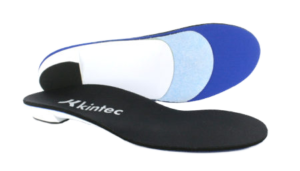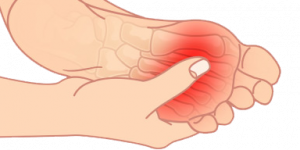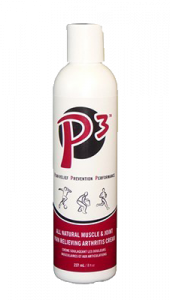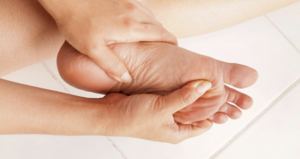The Complete Treatment Guide for Forefoot Pain
What is Forefoot Pain?
Do You Have Forefoot Pain?
Symptoms of Forefoot Pain
Metatarsalgia pain or forefoot pain usually appears as a dull ache or burning sensation around the ball of the foot. Neuromas can cause numbness or tingling in the toes, or sharp electric-like shocks that shoot up into the leg or down into the toes.
The pain usually increases with prolonged standing, walking or running, and subsides when the shoes are removed from the feet. People suffering from metatarsalgia also tend to have clawing or hammering of the toes.
What Causes Forefoot Pain?
Foot Mechanics: Normal feet have an arch across the ball of the foot called the metatarsal (or transverse) arch. When this arch falls it places additional pressure on the middle three bones. This fallen arch can also cause these bones to be squeezed together, pinching the soft tissues (nerves and tendons) that are in between and surrounding the bones.
Footwear: Footwear plays an important role. High-heeled shoes place additional weight on the ball of the foot and narrow pointed shoes squeeze the toes together. Footwear like this aggravates these conditions and should be avoided.
Rigid High Arch Feet: This places excessive pressure on the balls of the feet. This foot type can be prone to metatarsalgia and neuroma.
Flexible Flat Feet: With flexible flat feet as the arch of your foot falls, the foot lengthens. This causes excess shearing forces underneath and between the metatarsal bones. This foot type can be prone to metatarsalgia and neuroma.
Individual and Muscular Factors: As we age, much of the protective fat pad under the ball of the foot is lost. Weak foot muscles can cause the transverse (metatarsal) arch to collapse. Tight calf muscles promote early heel lift during walking. This places more stress on your forefoot. Weight gain also increases the stress on the ball of the foot.
How Do We Assess Your Forefoot Pain?
When you book an appointment with one of our Canadian Certified Pedorthists, we’ll perform a detailed assessment, which includes:
- a physical examination your feet
- a video gait analysis to evaluate the biomechanics of your feet and lower limbs—we analyze your pattern of movement when walking and determine how your feet and legs work together to produce movement
- a review of your activities, symptoms, and history of your foot and heel pain
- a personalized treatment plan for your unique situation
Our One2One program will provide you with the highest level of safety and personalized service for your assessments, as well as your orthotic, footwear and bracing needs.
How to Treat Forefoot Pain
Early treatment is essential. You should combine as many treatments as possible to obtain the best results. If poor foot function is involved, then long-term treatment is generally aimed at reducing the pressure on the forefoot and supporting the metatarsal arch. In the event of a severe neuroma, surgery may be required. It is usually done only as a last resort.
As part of your assessment with one of our Canadian Certified Pedorthists, we’ll provide a personalized treatment plan that may include some or all of the following treatments:
1. Medication
Anti-inflammatories (NSAID) may be prescribed by your doctor to reduce the pain and inflammation.
2. Proper Footwear
Eliminate high heels and narrow pointed toed shoes. Look for lower, wider fitting shoes that stretch easily to relieve pressure across the ball of the foot. Shoes that offer increased cushioning will help to protect your feet.
Footwear Tips:
- Choose a shoe with good shock absorption. A shock-absorbing midsole supports the contours of the foot and reduces pressure by allowing your foot to sink into the foam cushioning.
- Pick shoes with forefoot rocker. Forefoot rocker helps reduce the amount your foot needs to bend during toe-off. By limiting how much your forefoot bends, a strong forefoot rocker reduces pressure on the ball of your foot to help propel your foot forward and reduce stress on the forefoot pain.
We offer running shoes, casual shoes, and sandals to help heal and prevent forefoot pain. Visit a Kintec store today and our Fit Experts will help you find the perfect fit from our line of hand-selected footwear.
3. Metatarsal Pads
These pads can be placed in your shoes to re-establish the transverse arch. They can improve the alignment and help to relieve pressure on the nerves and soft tissues.
4. Custom Foot Orthotics
Orthotics play an important role when the cause of the pain is the result of poor foot function. They help to support and align your foot in a mechanically correct position and alleviate stress on the metatarsal heads and joints. This helps to protect your foot from damage caused by simple daily activity. Frequently, metatarsal pads are placed directly into the orthotic.
Learn more about custom orthotics.

We also offer the best over-the-counter insoles that can help heal and relieve forefoot pain. Visit a Kintec store today and our Fit Experts will help you find the perfect fit.
5. Physiotherapy
Physiotherapy can also help reduce pain and inflammation. Specific exercises may be prescribed to help strengthen any weak foot muscles.
How to Prevent Forefoot Pain
Early recognition and treatment can prevent the condition from progressing. If you are experiencing pain, consult your physician. They may refer you for a biomechanical assessment of your feet to start conservative treatment early.
Book an assessment today
Our Canadian Certified Pedorthists will perform a thorough analysis of your feet, biomechanics and history, and develop a comprehensive and personalized treatment plan for you.
Our One2One program will provide you with the highest level of safety and personalized service for your assessments, and all of your orthotic, footwear and bracing needs.
Our goal with assessment and treatment is to:
- provide you with education, support, and a personalized treatment plan
- minimize your risk of recurrent plantar fasciitis
- help you stay active on your feet, for life
If you have any questions, please call us at 604-200-3338 or make an appointment to visit us in-store.






